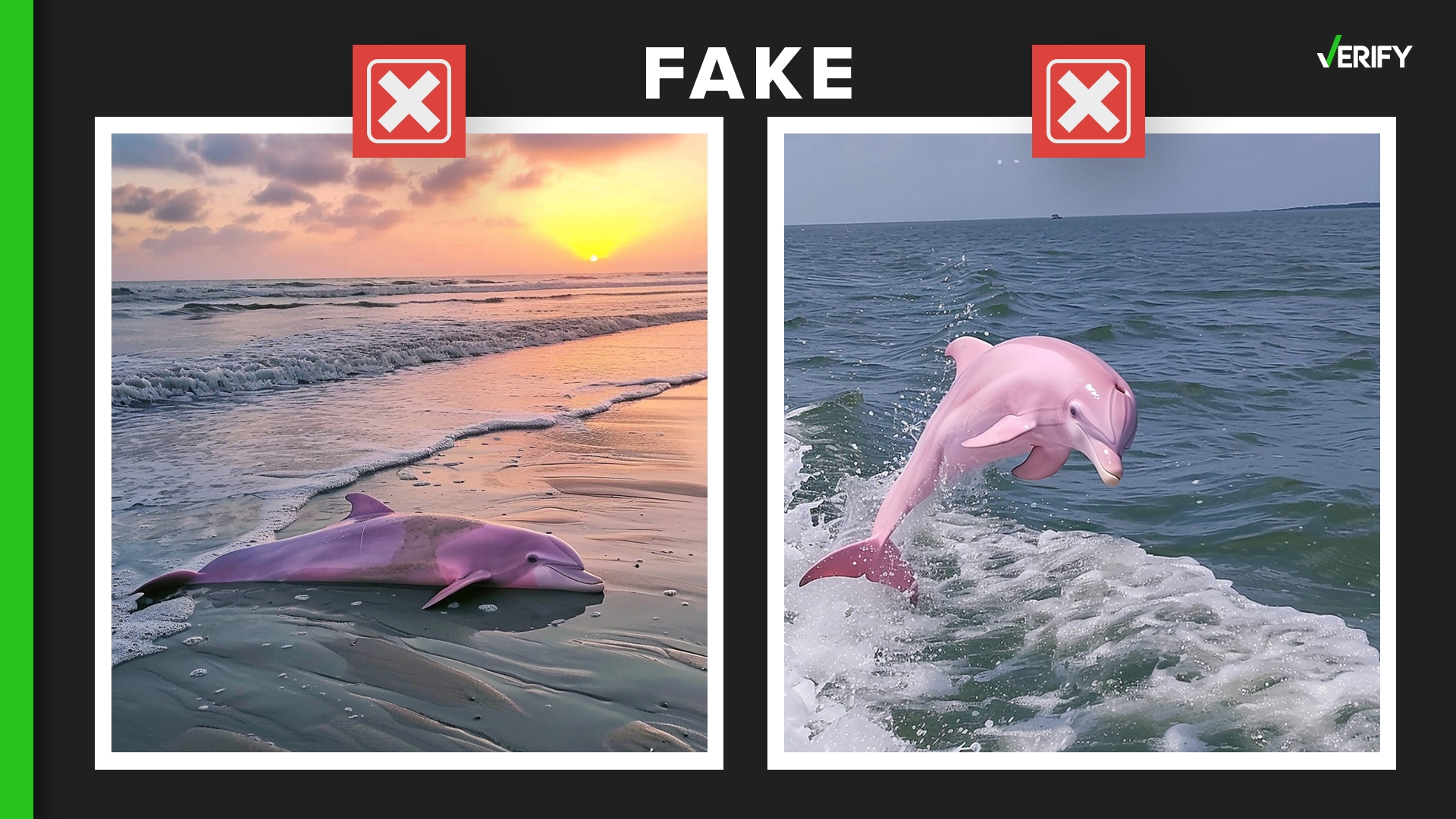Photos claiming to show a pink dolphin off the coast of North Carolina went viral on social media this week, racking up tens of thousands of likes, comments and shares.
A Facebook page called Outer Banks Vibes shared photos that claim to show a pink dolphin jumping in the air and another stranded on North Carolina’s Hatteras Beach.
“On the morning of June 19th, a beautiful and rare pink dolphin was discovered stranded on NC Hatteras beach, having been washed out of its natural habitat. A kind-hearted man saw the distressed dolphin and quickly took action to help it return to the ocean, ensuring its safety and well-being,” the second post reads.
Some people who commented on the Facebook posts believed the photos were real, while others questioned their authenticity. VERIFY reader Dylan also asked us if the photos are real.
THE QUESTION
Are photos claiming to show a pink dolphin in North Carolina real?
THE SOURCES
- Spokesperson for North Carolina’s Department of Marine Fisheries
- National Oceanic and Atmospheric Administration (NOAA) Fisheries Southeast Regional Office
- RevEye, a reverse image search tool
- VERIFY analysis of the images
- Alex Olivera, a marine biologist and senior Mexico representative for the Center for Biological Diversity
- RiverDolphins.org
- Blue World Institute, a nonprofit research and conservation organization
- Whale and Dolphin Conservation USA
THE ANSWER
No, photos claiming to show a pink dolphin in North Carolina are not real.
WHAT WE FOUND
While pink dolphins do exist, the photos claiming to show one in North Carolina are fake.
“We have not received any reports or verified photos of pink dolphins in North Carolina waters,” a spokesperson for the state’s Division of Marine Fisheries said.
Experts with the National Oceanic and Atmospheric Administration (NOAA) Fisheries Southeast Regional Office also confirmed to VERIFY that the images are not real.
VERIFY conducted reverse image searches on all of the viral pink dolphin photos and found that they had not been shared by any reputable news outlets. If a rare pink dolphin had been spotted in North Carolina, there would be news stories about the sighting.
There are also several indicators that the viral photos have been altered or were created with artificial intelligence (AI).
In one post, the dolphin in the photos has skin that lacks texture and looks too smooth. We also zoomed in on the first two photos in the post and found that the word “cola” appears to be written near the dolphin’s blowhole.
The dolphin’s skin also looks too smooth in the photos shared in another Facebook post. Both the sand and water in the photos also appear to be stylized, which usually indicates that an image is AI-generated.
Alex Olivera, a marine biologist who works for the Center for Biological Diversity, added that the photos look “color enhanced and/or edited,” which some people pointed out in the Facebook comments.
The Outer Banks Vibes Facebook page did not respond to VERIFY’s request for comment.
There are several types of “pink dolphins.” One is the Amazon river dolphin, which is a freshwater species that is found only in the rivers of South America. Indo-Pacific humpback dolphins, which are found in coastal waters across Asia, can also be pink.
Like humans, bottlenose dolphins can also be albino due to a genetic mutation that prevents their skin cells from producing melanin, which is a pigment that gives the dolphins their black and gray coloring.
Albino bottlenose dolphins can look pink, but it is “very unlikely to find a bottlenose dolphin with albinism,” Olivera said. These dolphins are so rare that only about 20 sightings have been recorded since the mid-20th century, the nonprofit Blue World Institute says.
However, albino bottlenose dolphins have been spotted in the U.S. A bottlenose calf with albinism was first photographed in June 2007 at Calcasieu Lake in southeastern Louisiana, NOAA says.
Since then, there have been at least several other reported sightings of albino bottlenose dolphins in Louisiana, including one in July 2023.

